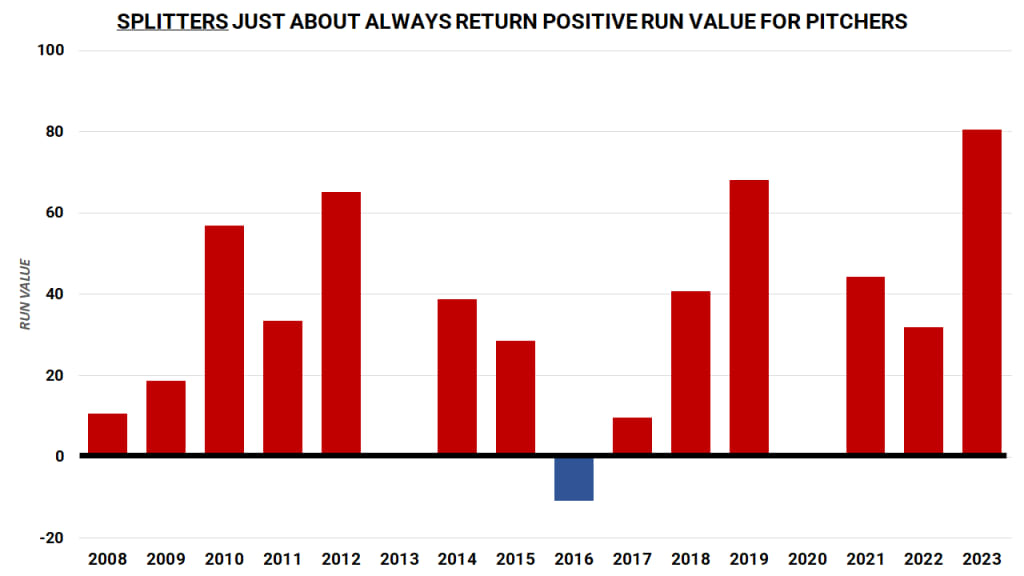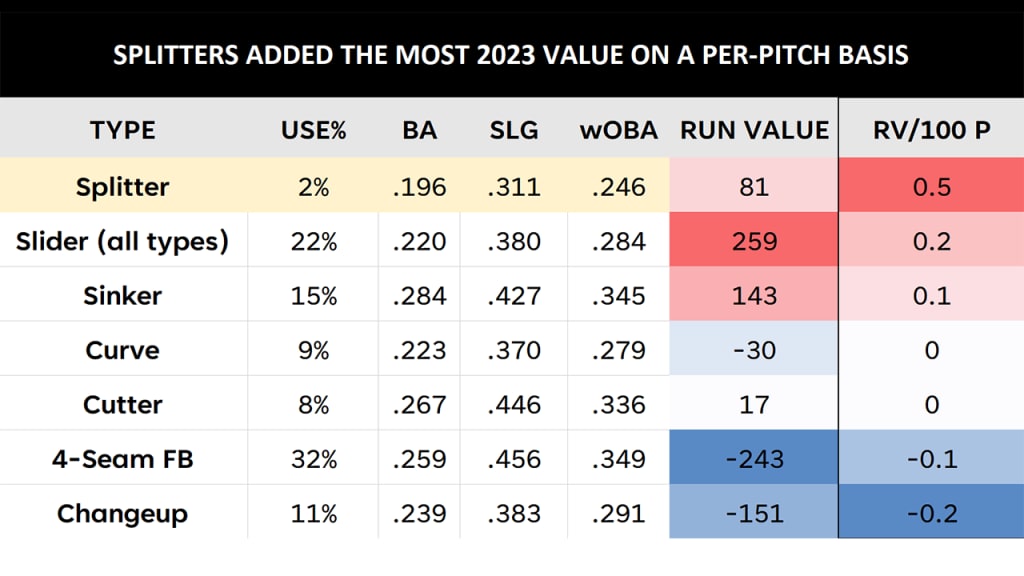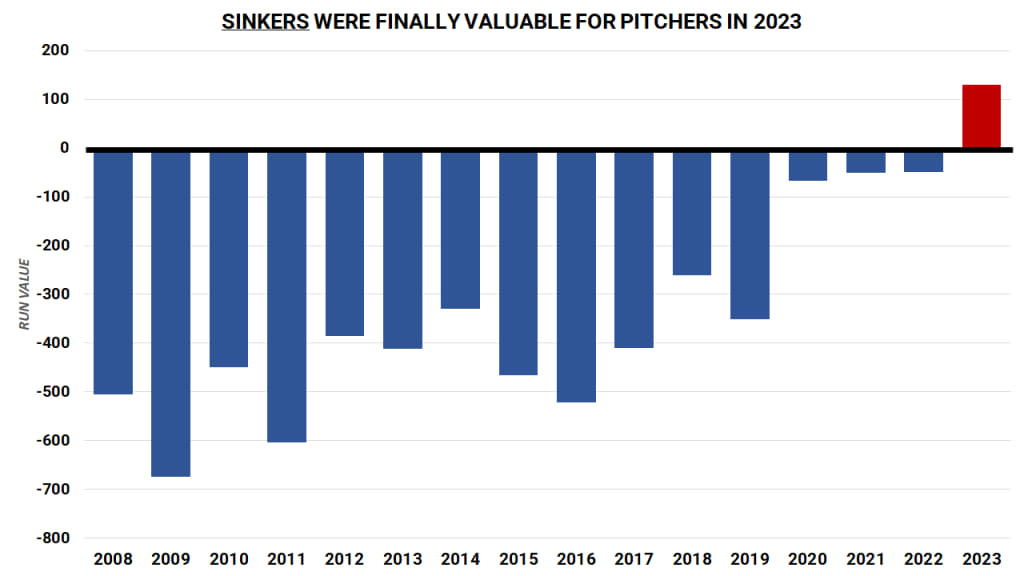Every few years, there’s a “hot new pitching trend” in baseball, even if it’s just an old one coming back in a new way.
A decade ago, clever teams (like the Pirates) were getting ahead by using low sinkers to make batters hit into shifted defenses. As more advanced pitch-tracking technology came online, the high-spin, bat-missing high fastball was all the rage, making teams who continued to rely on the sinker (like the Pirates) for weak contact look behind the times. Then it was the high-velocity slider, and the cutter to take up the space between them, and as you certainly noticed if you watched baseball in 2023, the sweeper.
At every turn, pitchers have been ahead, and then batters have adjusted, and then pitchers have done something else. There’s already evidence the high fastball isn’t as effective as it once was, and there’s already evidence that all those sliders aren’t performing as well as they once did. It’s an endless game of cat and mouse, forcing pitchers to move on to the next big thing.
So what is the next big thing? It might be the sinker, again. It’s almost certainly the splitter, too. These aren’t trends that are coming. These are trends that have already started. By looking back at what just happened in 2023, we can get an idea of what we might get to see in 2024.
1) The splitter is the next it-pitch to watch. Again.
The splitter (here and going forward we’ll include the rarely-seen forkball, because Kodai Senga’s “ghost fork” is essentially a splitter) has never been one of the primary pitches in the sport; in all the years of pitch tracking, it’s never risen above a mere 2.3% of all pitches, as it did in 2023. As Zach Crizer detailed last June, that’s in large part due to decades of presumption – not terribly backed up by evidence – that throwing it can cause injury more easily than most other pitches.
That lack of usage belies its outright dominance. Other than a minor blip in 2016, splitters have been average or above pitches for hurlers for the entirety of the pitch-tracking era (since 2008). (Run value, shown here, includes every pitch, not just the ones that end a plate appearance. If you get ahead 0-2 on two splitters and then allow a hit on a curve, there’s still value in what the splitter did in getting strikes.)

Just looking at 2023 and compared to other pitch types, you can see that the splitter is the most effective offering on a per-pitch basis. If we showed this all the way back to 2008, you'd get a similar result.

“Those are just very difficult pitches to both identify for a hitter, but also to barrel up,” Tigers president of baseball operations Scott Harris told MLB.com’s Jason Beck recently. “I think splits on a population level have performed really well in baseball.”
The value is clear. So what makes us think that a change in usage is coming?
It’s partially that last year, we saw nearly 4,000 more splits and forks than in any other year of the pitch tracking era, and that’s only a little about the arrival of Senga. For example, in 2022, there were five pitchers who used their splitter more than 5% of the time who had used it less than that the previous year. In 2023, there were 13 such pitchers, successful ones like Logan Gilbert, Joe Ryan, George Kirby, Robert Stephenson and Shelby Miller, who upped their games with either a brand-new split or just using an old one more.
(Not included but relevant: Tampa Bay’s Zack Littell, who went from a well-traveled reliever to a surprisingly good starter. He also threw a splitter 19% of the time, or nearly 4x what he’d done two years earlier. When he learned it in 2021, he said he was told that "the way your body moves, the way your mechanics are, a splitter might be the pitch for you." Keep that idea in your back pocket as we proceed.)
We’ve also seen pitchers like Kevin Gausman and Alex Cobb, long-time splitter practitioners, lean on it more and more as a primary pitch, not a secondary one. In August, Cobb set what is at the very least a pitch-tracking era record by throwing 83 of them in a game, on a night where he came within one out of throwing a no-hitter.
This winter, we know that Dylan Cease is trying to learn Gausman’s splitter, saying “I got Gausman’s grip. I’m going to see if I can learn that this offseason.” Gausman’s grip is a popular one; it’s what Kirby picked up last year, before allowing just two extra base hits on the 172 that he threw. We know that his Seattle teammate Bryce Miller is working on one, too. If and when Braves prospect Hurston Waldrep makes it up, watch out for what FanGraphs called “his freaky splitter.”
Even on a much smaller scale, when the Orioles acquired Tucker Davidson in October, it wasn’t because they liked his 5.98 career ERA. It might have been because the splitter he threw 63 times last year allowed two hits, a 0% hard-hit rate, and a 53% swing-and-miss rate.
Or think about Erick Fedde, who was unsuccessful for years with Washington before going to Korea, winning an MVP award, and returning to sign with the White Sox this winter. He’ll have a new weapon or two, as new Sox senior pitching advisor Brian Bannister noted.
The performance on splitters is so good that even if the injury risk was higher – and again, the evidence doesn’t really support that – there’s an incentive for fringe pitchers to take on that risk to get to higher performance that would allow them to have or sustain a big league career, as opposed to a lower-risk approach that keeps them in the Minors.
It’s also now been two years since Driveline’s Director of Pitching, Chris Langin, penned this thread about how splitters are “a market inefficiency…”
… and since then, a number of those Driveline trainees have come away with a certain new pitch.
It’s in part because the baseball industry is learning more about how pitchers move their bodies – the terms supination and pronation are more than we’re getting into today, but knowing what you’re good at helps define what pitches you might be a good candidate to throw, as Littell alluded to – and in part because it’s an extremely platoon-neutral pitch, with righty splitters finding nearly identical outcomes against righty hitters and lefty hitters.
“Splits have a lot of things going for them,” said Detroit’s Harris. “They’re generally platoon-neutral pitches; they are effective against righties and lefties. A lot of the best ones have very late movement that deceives hitters.”
Besides, this trend is an easy one to predict. Remember what this was in reference to?
That was during the World Baseball Classic, when it seemed like the entire Team Japan pitching staff was carving up opposing lineups with a splitter. While not all games in the WBC were played in parks with Statcast tracking, of the ones that were, we saw 55% of all splitters thrown in the tourney coming from one single pitching staff: Team Japan.
Realize, now, that there are at least three prominent Japanese pitchers coming to the Majors in 2024:
- Yoshinobu Yamamoto (Dodgers)
- Shōta Imanaga (Cubs)
- Yuki Matsui (Padres)
“Yamamoto's curveball is the beautiful pitch, but his splitter might be his nastiest offering,” wrote David Adler when previewing Yamamoto’s repertoire. In the WBC, one-third of Yamamoto’s pitches were splitters. Imanaga’s splitter is the rare one that comes from a lefty, and he’ll be joined by Matsui, another lefty, with another split of his own.
Furthermore, new Blue Jays pitcher Yariel Rodríguez, who spent parts of four seasons in Japan, reportedly features the split. There might even be more: The Rays signed Naoyuki Uwasawa to a Minor League deal, and if he manages to see big league time, “he throws an effective forkball,” i.e., a splitter.
It seems clear we’re going to be reading stories all spring about new splitters. Of course, it’s not really a new pitch.
While anecdotes aren’t exactly data, it’s hard to ignore things like Jack Morris once saying that “I’m not sure [Babe] Ruth could have hit the split-finger,” and “I’ve seen pictures of Ty Cobb swing, and I know he couldn’t.” As Crizer also passed along, none other than the legendary Tony Gwynn said that the splitter was the most difficult pitch for him to face. “When [Kevin Brown] mixes the splitter in with a 95-mph heater and a slider,” wrote Gwynn for ESPN in 2001, “wow, I'm glad I retired.”
In the 1970s, Bruce Sutter famously used it extensively on his way to a Hall of Fame career. In 1986, Sports Illustrated called it “the pitch of the ‘80s,” thanks to Roger Craig’s Giants rotation, as well as Morris, Ron Darling, Mike Scott, Orel Hershisher and others. It was, according to MLB official historian John Thorn, invented back in 1908 by Bert Hall.
That was all a long time ago. Even if the splitter was seen more than ever in the postseason last year, that was still just a mere 3.2% of the time, which reiterates how rare the pitch remains. (Look no further than this 2011 New York Times article featuring multiple pitching coaches worrying about injury – “it’s a pitch we really try to shy off of,” said then-Twins coach Rick Anderson – to understand why.) Even Clayton Kershaw tried one out, briefly.
It won’t take much to get above 3% usage this year, which would be a modern high. It still might not be enough.
But 2024 isn’t just about the potential rise of an underused pitch, either. It might be about the return-in-progress of a pitch long thought to be deceased.
2) The sinker was actually valuable in 2023.

That graph is saying exactly what you think it is: For the first time in the decade-and-a-half of pitch tracking, the sinker provided a positive overall run value for pitchers in 2023.
Even back in what’s remembered as the 2012-’14 recent heyday of the sinker, it was still a negative overall pitch, because while a handful of teams like the Braves, D-Backs, Rays, and Pirates were using it to positive effect, many, many more teams were not. “Baseball is moving away from the sinker,” wrote FanGraphs in 2017, and the pitch was so dead that by 2019, the analytically focused site Beyond the Box Score ran a headline that read “A call for pitchers to stop throwing sinkers (It isn’t working.)”
But from 2020-’22, it came closer to neutral value, before last year: Positive value, for the first time. (It might be even better than that, too, if not for the Rockies posting a minus-80 run value with the pitch, the weakest team sinker season in more than a decade.)
What’s bringing the sinker back? Let’s dig through a few theories.
A) It’s added velocity at a faster rate than the four-seamer has.
Let’s get the easy stuff out of the way. Everything is being thrown harder, but the sinker is really being thrown harder.
Between 2008-’23, the rate of four-seam fastballs being thrown 95 mph or harder has basically doubled, from 17% to 38%. But the rate of sinkers being thrown 95-plus mph has quadrupled, from 7% to 28%. While that’s still less than four-seamers, these are pitches that move more, too. They’re thrown less to get weak contact, and more with the intent of being nasty.
"Before, the sinker used to be guys throwing 90, 91 mph, and now you've got guys throwing 100," Yankees star Aaron Judge told MLB.com’s David Adler. "I've worked on hitting those pitches, especially when they're coming in off the plate. I didn't know I was gonna get attacked like that.”
B) They’re being used in better (or less bad) situations.
We know this to be true, because analysts Ben Clemens and Justin Choi already proved it to be true early last season, showing that part of what was happening is that pitchers who throw sinkers have become much smarter about not using them to opposite-handed hitters. Let’s update their numbers through the rest of 2023.

For years, nearly half of right-handed sinkers went to lefty batters, and sinkers aren't platoon-free pitches like splitters. That’s dropped down below one-third, and the trend doesn't seem to stop. A good way to make a pitch seem better, then: Stop throwing the ones that make it seem worse.
C) The sinkers themselves may just be better.
It’s not a coincidence that 2020 was a turning point here, as it was for the sweeper, as that’s when new Hawk-Eye pitch tracking technology came online – and every team analyst and coach suddenly had far too much unwanted time on their hands to think about it. That led to the rise of seam shifted wake, which is the science of using the seams themselves to get extra and unexpected movement – and studies have shown both that the sinker is a well-suited pitch for the effect, and that it can increase the value of the pitches the better you get at harnessing it.
We know that 2023 was tied for the most average arm-side movement on sinkers in the pitch tracking era. We know that the velocity is up. We know that they’re also being thrown from the lowest release point in the pitch tracking era, a half-foot lower than its 2009 peak, as the sport gets a better handle on approach angles. Can we see if there are examples of pitchers with more seam-shifted wake (SSW) effects?
One good one is Baltimore’s Yennier Cano, who had an absolutely out-of-nowhere breakout in 2023 that was in large part due to his improved sinker. In 2022, that pitch had a minus-5 run value and a .400 average against; in 2023, it had a plus-17 run value and a .241 average against. As we detailed in May, it was easy to see that Cano had solidified his release point in a way that likely made it more difficult for batters to pick up the pitch out of his hand.
But if we measure the side force applied to the pitch, which is likely to be attributed to the seams, we can see that in 2022, Cano threw 48% of his sinkers with at least two inches of likely-due-to-the-seams side force … and in 2023, that was 99%. If you like fancy pitch-modeling metrics, then Stuff+ shows that Cano’s sinker went from one of the worst in 2022 to one of much higher quality in 2023.
It’s too soon to say this is a trend across the Majors. It’s too far into it to ignore, either.
It’s also possible that the sport is just getting better at identifying the pitchers who should and shouldn’t be throwing them, like Littell said, rather than making it a one-size-fits-all trend. After all, we’ve seen examples of pitchers attempting to chase that high-spin four-seamer and realize they just can’t succeed that way, before going to the sinker, often thrown from a lower arm angle, with great success. Corbin Burnes is a great example of this, after his 8.82 ERA in 2019, yet he’s not the only one.
“After two months of me trying to [increase spin rate],” Giants ace Logan Webb told Sports Illustrated in 2022, “[Bannister] calls me and he goes, ‘No, we’re not doing that. You're gonna throw like Chris Sale,’” Webb says. “And I'm like, ‘Chris Sale? He’s, like, sidearm!’"
After a 5.36 ERA in his first two seasons, Webb has posted a 3.07 since. To a somewhat lesser extent, we saw a big turnaround from Arizona’s Brandon Pfaadt last year, who returned from a midseason demotion to Triple-A with a new sinker that he used to help him tunnel off his sweeping slider, as Webb also does. It’s not a coincidence that many successful sinker pitchers use it horizontally to play off a slider moving the opposite direction.
“The sinker plays in today’s game,” said three-time All Star Jake Peavy last summer.
“Eventually, there could and should be a sinker resurgence,” wrote Rays analyst Jeff Sullivan (then at FanGraphs) in 2017 in an article examining the decline of the pitch, “but this seems like it’s the four-seamer’s time to shine.”
He was right. It was. It might not be any longer.
